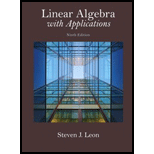
Concept explainers
The result of Exercise 26 is not valid for norms other than the norm derived from the inner product. Give an example of this in
Want to see the full answer?
Check out a sample textbook solution
Chapter 5 Solutions
Linear Algebra with Applications (9th Edition) (Featured Titles for Linear Algebra (Introductory))
Additional Math Textbook Solutions
Pathways To Math Literacy (looseleaf)
Elementary Statistics Using The Ti-83/84 Plus Calculator, Books A La Carte Edition (5th Edition)
Elementary Statistics: Picturing the World (7th Edition)
Precalculus
Elementary & Intermediate Algebra
College Algebra (Collegiate Math)
- Solve using the quadratic equation formula 4x² + 12x=-6 ○ a) -12±√√3 2 b) -3±√15 -3+√15 2 ○ c) c) -3±√√√3 2 d) -3±√3 8arrow_forwardListen Solve the quadratic equation by factoring. One solution is 0. Find the other. 2x² + 16x = 0 Your Answer: Answerarrow_forwardSolve x²+4x-45 = 0 ○ A) -9,5 ☐ B) -15, 3 C) -3,15 D) -5,9arrow_forward
- Solve 3x² + 2x-5=0 О ○ A) 3,- 11/1 ○ B) 1,- 5/35 5 Oc)-1, 33 ○ D) 1, - 3/3arrow_forwardFactor the polynomial completely. x^2- 9 A) (x - 1)(x -9) B) (x - 3)(x + 3) c) (x -3)(x-3) D) (x + 3)(x + 3)arrow_forwardDirections: Use the equation A = Pet to answer each question and be sure to show all your work. 1. If $5,000 is deposited in an account that receives 6.1% interest compounded continuously, how much money is in the account after 6 years? 2. After how many years will an account have $12,000 if $6,000 is deposited, and the account receives 3.8% interest compounded continuously? 3. Abigail wants to save $15,000 to buy a car in 7 years. If she deposits $10,000 into an account that receives 5.7% interest compounded continuously, will she have enough money in 7 years? 4. Daniel deposits $8,000 into a continuously compounding interest account. After 18 years, there is $13,006.40 in the account. What was the interest rate? 5. An account has $26,000 after 15 years. The account received 2.3% interest compounded continuously. How much was deposited initially?arrow_forward
- TRIANGLES INDEPENDENT PRACTICE ription Criangle write and cow Using each picture or description of triangle write and solve an equation in ordering the number of degrees in each angle TRIANGLE EQUATION & WORK ANGLE MEASURES A B -(7x-2)° (4x) (3x)° (5x − 10) C (5x – 2) (18x) E 3. G 4. H (16x)° LL 2A= 2B= ZE=arrow_forwardAnswer ASAP and every part, please. Structures.arrow_forwardsearch P(QP) Q 1.-P:PR 2.-QP:PR 3. Q:MT 1, 2 4. Q:DNE 3 Submit 4.5 P. (QP) Q 1. P: PR 2. Q-P PR 3. -Q:AS 4. -P:MP 2, 3 5. Submit 17 A Previous Chapter Next Chapterarrow_forwardarrow_back_iosSEE MORE QUESTIONSarrow_forward_ios
 Elementary Linear Algebra (MindTap Course List)AlgebraISBN:9781305658004Author:Ron LarsonPublisher:Cengage Learning
Elementary Linear Algebra (MindTap Course List)AlgebraISBN:9781305658004Author:Ron LarsonPublisher:Cengage Learning Linear Algebra: A Modern IntroductionAlgebraISBN:9781285463247Author:David PoolePublisher:Cengage Learning
Linear Algebra: A Modern IntroductionAlgebraISBN:9781285463247Author:David PoolePublisher:Cengage Learning

